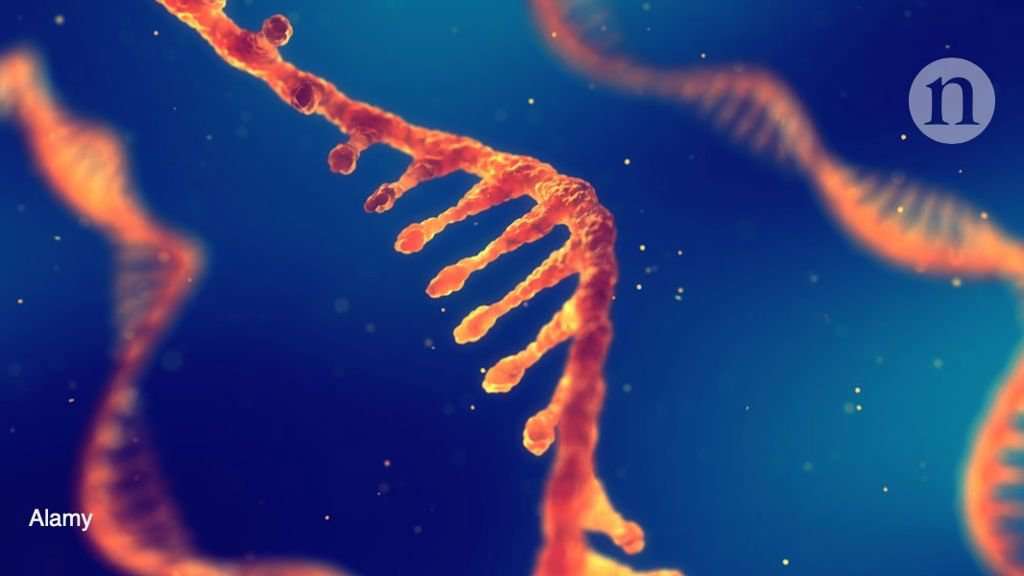RNA has been synthesized in conditions that may have resembled those on the early Earth.Credit: Alamy
If Thomas Carell is right, around 4 billion years ago, much of Earth might have been blanketed with a greyish-brown kind of mineral. This was no ordinary rock, however: it consisted of crystals of the organic molecules that scientists now call A, U, C and G. And some of these, the theory goes, would later serve as the building blocks of RNA, the evolutionary engine of the first living organisms, before DNA existed.
Carell, an organic chemist, and his collaborators have now demonstrated a chemical pathway that — in principle — could have made A, U, C and G (adenine, uracil, cytosine and guanine, respectively) from basic ingredients such as water and nitrogen under conditions that would have been plausible on the early Earth. The reactions produce so much of these nucleobases that, millennium after millennium, they could have accumulated in thick crusts, Carell says. His team describes the results in Science on 3 October1.
The results add credence to the ‘RNA world’ hypothesis, says Carell, who is at the Ludwig Maximilian University of Munich in Germany. This idea suggests that life arose from self-replicating, RNA-based genes — and that only later did organisms develop the ability to store genetic information in the molecule’s close relative, DNA. The chemistry is also a “strong indication” that the appearance of RNA-based life was not an exceedingly lucky event, but one that is likely to happen on many other planets, he adds.
In previous work in 2016, Carell’s team had found chemical reactions that spontaneously yielded the nucleobases A and G2. A separate group had done a similar proof-of-principle3 for the other two, U and C in 2009. But the two pathways seemed incompatible with each other, requiring different conditions, such as divergent temperatures and pH.
Now, Carell’s team has shown how all nucleobases could form under one set of conditions: two separate ponds that cycle through the seasons, going from wet to dry, from hot to cold, and from acidic to basic, and with chemicals occasionally flowing from one pond to the other. The researchers first let simple molecules react in hot water and then allowed the resulting mix to cool down and dry up, forming a residue at the bottom that contained crystals of two organic compounds.
They then added water back, and one of the compounds dissolved and was washed away into another reservoir. The absence of that water-soluble molecule allowed the other compound to undergo further reactions. The researchers then mixed the products again, and their reactions formed the nucleobases.
“This paper has demonstrated marvellously the chemistry that needs to take place so you can make all the RNA nucleosides,” says Ramanarayanan Krishnamurthy, a chemist at Scripps Research in La Jolla, California. But he and other researchers often warn that this and similar results are based on hindsight and might not offer credible guidance as to how life actually evolved.
The next major problem Carell wants to tackle is what reactions could have formed the sugar ribose, which needs to link to nucleobases before RNA can form.

darm0k on October 5th, 2019 at 03:54 UTC »
RNA and DNA are so interesting. They baffled scientists for ages but are finally such beautifully succinct, simple molecules in structure and mechanism. The first guy to ever find DNA actually called it a “stupid molecule” because he thought it just provided the backbone to the true carrier of our genetic information. But no, these simple, unassuming molecules are somehow the key to all life on this planet. Unbelievable.
Cuddlefooks on October 5th, 2019 at 02:13 UTC »
I thought this has been shown long ago?
Delta_Foxtrot_1969 on October 5th, 2019 at 02:01 UTC »
“But he and other researchers often warn that this and similar results are based on hindsight and might not offer credible guidance as to how life actually evolved.”